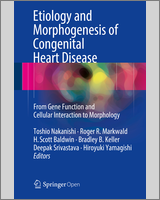Open Access This chapter is distributed under the terms of the Creative Commons Attribution-Noncommercial 2.5 License (http://creativecommons.org/licenses/by-nc/2.5/), which permits any noncommercial use, distribution, and reproduction in any medium, provided the original author(s) and source are credited. The images or other third party material in this chapter are included in the work's Creative Commons license, unless indicated otherwise in the credit line; if such material is not included in the work's Creative Commons license and the respective action is not permitted by statutory regulation, users will need to obtain permission from the license holder to duplicate, adapt or reproduce the material.
NCBI Bookshelf. A service of the National Library of Medicine, National Institutes of Health.
Nakanishi T, Markwald RR, Baldwin HS, et al., editors. Etiology and Morphogenesis of Congenital Heart Disease: From Gene Function and Cellular Interaction to Morphology [Internet]. Tokyo: Springer; 2016. doi: 10.1007/978-4-431-54628-3_16

Etiology and Morphogenesis of Congenital Heart Disease: From Gene Function and Cellular Interaction to Morphology [Internet].
Show detailsCongenital hypothyroidism (CH) is one of the most common diseases of the endocrine system among newborns. Infants with CH have been reported to have a high frequency of congenital cardiovascular malformations (CM), such as ventricular and atrial septal defects [1]. Some studies have demonstrated that these cases were due to gene mutations and neural crest abnormality. Infants with CH and CM have been shown to have significantly lower T4 levels than those with isolated CH. However, the role of thyroid hormone in the developing heart has not been reported. In this study, we show the thyroid anlage in chick embryos by immunohistochemistry and follow the expression of thyroid hormone receptor during heart development.
Keywords:
Thyroid, Thyroid hormone, Thyroid hormone receptor, Heart, Chick embryoCongenital hypothyroidism (CH) is one of the most common diseases of the endocrine system among newborns. Infants with CH have been reported to have a high frequency of congenital cardiovascular malformations (CM), such as ventricular and atrial septal defects [1]. Some studies have demonstrated that these cases were due to gene mutations and neural crest abnormality. Infants with CH and CM have been shown to have significantly lower T4 levels than those with isolated CH. However, the role of thyroid hormone in the developing heart has not been reported. In this study, we show the thyroid anlage in chick embryos by immunohistochemistry and follow the expression of thyroid hormone receptor during heart development.
- 1.
The thyroid anlage appeared close to the aortic sac at H/H 14 of chick embryos, as determined by immunohistochemistry (Fig. 16.1a).
- 2.
Avians have access to thyroid hormone long before the embryonic thyroid gland starts to secrete hormones due to the hormone deposition in the yolk and egg white [2].
- 3.
We found that the expression of thyroid hormone receptors during embryonic heart development was earlier than that reported previously published study using RT-PCR (Fig. 16.1b) [3].
These results suggest that thyroid hormone may contribute to the development of the heart.
References
- 1.
- Olivieri A, Stazi MA, Mastroiacovo P, et al. A population-based study on the frequency of additional congenital malformations in infants with congenital hypothyroidism: data from the Italian Registry for Congenital Hypothyroidism (1991–1998). J Clin Endocrinol Metab. 2002;87:557–62. [PubMed: 11836285]
- 2.
- Prati M, Calvo R, Morreale G, Morreale de Escobar G. L-thyroxine and 3,5,3′-triiodothyronine concentrations in the chicken egg and in the embryo before and after the onset of thyroid function. Endocrinology. 1992;130:2651–9. [PubMed: 1572286] [CrossRef]
- 3.
- Forrest D, Sjöberg M, Vennström B. Contrasting developmental and tissue-specific expression of alpha and beta thyroid hormone receptor genes. EMBO J. 1990;9:1519–28. [PMC free article: PMC551844] [PubMed: 1970296]
- Higher incidence of thyroid agenesis in Mexican newborns with congenital hypothyroidism associated with birth defects.[Early Hum Dev. 2012]Higher incidence of thyroid agenesis in Mexican newborns with congenital hypothyroidism associated with birth defects.Monroy-Santoyo S, Ibarra-González I, Fernández-Lainez C, Greenawalt-Rodríguez S, Chacón-Rey J, Calzada-León R, Vela-Amieva M. Early Hum Dev. 2012 Jan; 88(1):61-4. Epub 2011 Aug 3.
- A population-based study on the frequency of additional congenital malformations in infants with congenital hypothyroidism: data from the Italian Registry for Congenital Hypothyroidism (1991-1998).[J Clin Endocrinol Metab. 2002]A population-based study on the frequency of additional congenital malformations in infants with congenital hypothyroidism: data from the Italian Registry for Congenital Hypothyroidism (1991-1998).Olivieri A, Stazi MA, Mastroiacovo P, Fazzini C, Medda E, Spagnolo A, De Angelis S, Grandolfo ME, Taruscio D, Cordeddu V, et al. J Clin Endocrinol Metab. 2002 Feb; 87(2):557-62.
- [Tc]-99m thyroid scintigraphy in congenital hypothyroidism screening program.[J Trop Pediatr. 2006][Tc]-99m thyroid scintigraphy in congenital hypothyroidism screening program.Iranpour R, Hashemipour M, Amini M, Talaei SM, Kelishadi R, Hovsepian S, Haghighi S, Khatibi Kh. J Trop Pediatr. 2006 Dec; 52(6):411-5. Epub 2006 Aug 30.
- Review Neonatal thyroid disorders.[Horm Res. 2003]Review Neonatal thyroid disorders.Grüters A, Biebermann H, Krude H. Horm Res. 2003; 59 Suppl 1:24-9.
- Review Congenital hypothyroidism clinical aspects and late consequences.[Pediatr Endocrinol Rev. 2003]Review Congenital hypothyroidism clinical aspects and late consequences.Büyükgebiz A. Pediatr Endocrinol Rev. 2003 Dec; 1 Suppl 2:185-90; discussion 190.
- The Role of the Thyroid in the Developing Heart - Etiology and Morphogenesis of ...The Role of the Thyroid in the Developing Heart - Etiology and Morphogenesis of Congenital Heart Disease
Your browsing activity is empty.
Activity recording is turned off.
See more...
 2 and
2 and 